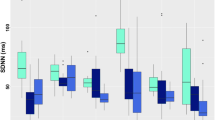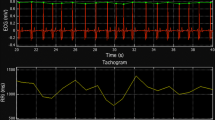Abstract
Heart rate variability (HRV) is a simple and non-invasive method for autonomous nervous system activity and probability of cardiovascular morbidity and mortality monitoring. However, the high scatter of HRV parameter values, found in both intraindividual and homogeneous intergroup measurements, inhibits the process of determining normal values or the ones indicating certain diseases. Such a process could be useful in clinical practice.
The aim of this work was to compare the scatter of a selection of HRV parameters from linear, frequency and nonlinear domains. They were compared using three different methods: between persons, between consecutive nights and between 45 min fragments of RR time intervals.
The largest mean scatter of HRV parameters was found in method 2 and the lowest in method 1. In all scales, correlation dimension, Lyapunov exponent, and unnormalized frequency parameters were the most scattered among the methods. Shannon entropy, Hurst exponent, DFA method’s \(\alpha \) exponent and mean RR interval had the lowest scatter. Low scatter of HRV parameters may be useful for determining the normal values of a parameter, however the quality of information carried by HRV parameter should be considered too.
The questionnaire revealed that the subjects formed a uniform group regarding the daytime events. Most participants did not have any highly stressful or exciting events. The sleep quality, however, was distributed almost equally over the possible answers.
The large dispersion of most parameters in different time scales indicates a high uncertainty in the interpretation of single measurements of the series of RR time intervals, because they may deviate from the typical values for the patient. The allostatic regulation of the organism should be considered using the averaged results to minimize the impact of intraindividual and interindividual variability.
Access this chapter
Tax calculation will be finalised at checkout
Purchases are for personal use only
Similar content being viewed by others
References
Task Force of the European Society Electrophysiology: Heart rate variability. Circulation 93, 1043–1065 (1996)
Nunan, D., Sandercock, G.R.H., Brodie, D.A.: Quantitative systematic review of normal values for short-term heart rate variability in healthy adults. Pacing Clin. Electrophysiol. 33, 1407–1417 (2010)
Porta, A., et al.: Entropy, entropy rate, and pattern classification as tools to typify complexity in short heart period variability series. IEEE Trans. Biomed. Eng. 48, 1282–1291 (2001)
Peng, C.-K., Havlin, S., Stanley, H.E., Goldberger, A.L.: Quantification of scaling exponents and crossover phenomena in nonstationary heartbeat time series. Chaos Interdisciplinary J. Nonlinear Sci. 5, 82–87 (1995)
Shannon, C.E.: A mathematical theory of communication. Bell Syst. Tech. J. 27, 379–423 (1948)
Richman, J.S., Moorman, J.R.: Physiological time-series analysis using approximate entropy and sample entropy. Am. J. Physiol. Heart Circulatory Physiol. 278, H2039–H2049 (2000)
Gierałtowski, J., Żebrowski, J.J., Baranowski, R.: Multiscale multifractal analysis of heart rate variability recordings with a large number of occurrences of arrhythmia. Phys. Rev. E 85, 021925 (2012)
Grassberger, P., Procaccia, I.: Measuring the strangeness of strange attractors. In: Hunt, B.R., Li, T.Y., Kennedy, J.A., Nusse, H.E. (eds.) The Theory of Chaotic Attractors, pp. 170–189. Springer, New York (2004). https://doi.org/10.1007/978-0-387-21830-4_12
Rosenstein, M.T., Collins, J.J., Luca, C.J.D.: A practical method for calculating largest Lyapunov exponents from small data sets. Physica D Nonlinear Phenom. 65, 117–134 (1993)
Golińska, A.K.: Poincaré plots in analysis of selected biomedical signals. Stud. Logic Grammar Rhetoric 35, 117–127 (2013)
Costa, M.D., Davis, R.B., Goldberger, A.L.: Heart rate fragmentation: a new approach to the analysis of cardiac interbeat interval dynamics. Front. Physiol. 8, 255 (2017)
Author information
Authors and Affiliations
Corresponding author
Editor information
Editors and Affiliations
Rights and permissions
Copyright information
© 2022 The Author(s), under exclusive license to Springer Nature Switzerland AG
About this paper
Cite this paper
Pater, A., Soliński, M. (2022). Scatter Comparison of Heart Rate Variability Parameters. In: Piaseczna, N., Gorczowska, M., Łach, A. (eds) Innovations and Developments of Technologies in Medicine, Biology and Healthcare. EMBS ICS 2020. Advances in Intelligent Systems and Computing, vol 1360. Springer, Cham. https://doi.org/10.1007/978-3-030-88976-0_15
Download citation
DOI: https://doi.org/10.1007/978-3-030-88976-0_15
Published:
Publisher Name: Springer, Cham
Print ISBN: 978-3-030-88975-3
Online ISBN: 978-3-030-88976-0
eBook Packages: Intelligent Technologies and RoboticsIntelligent Technologies and Robotics (R0)




